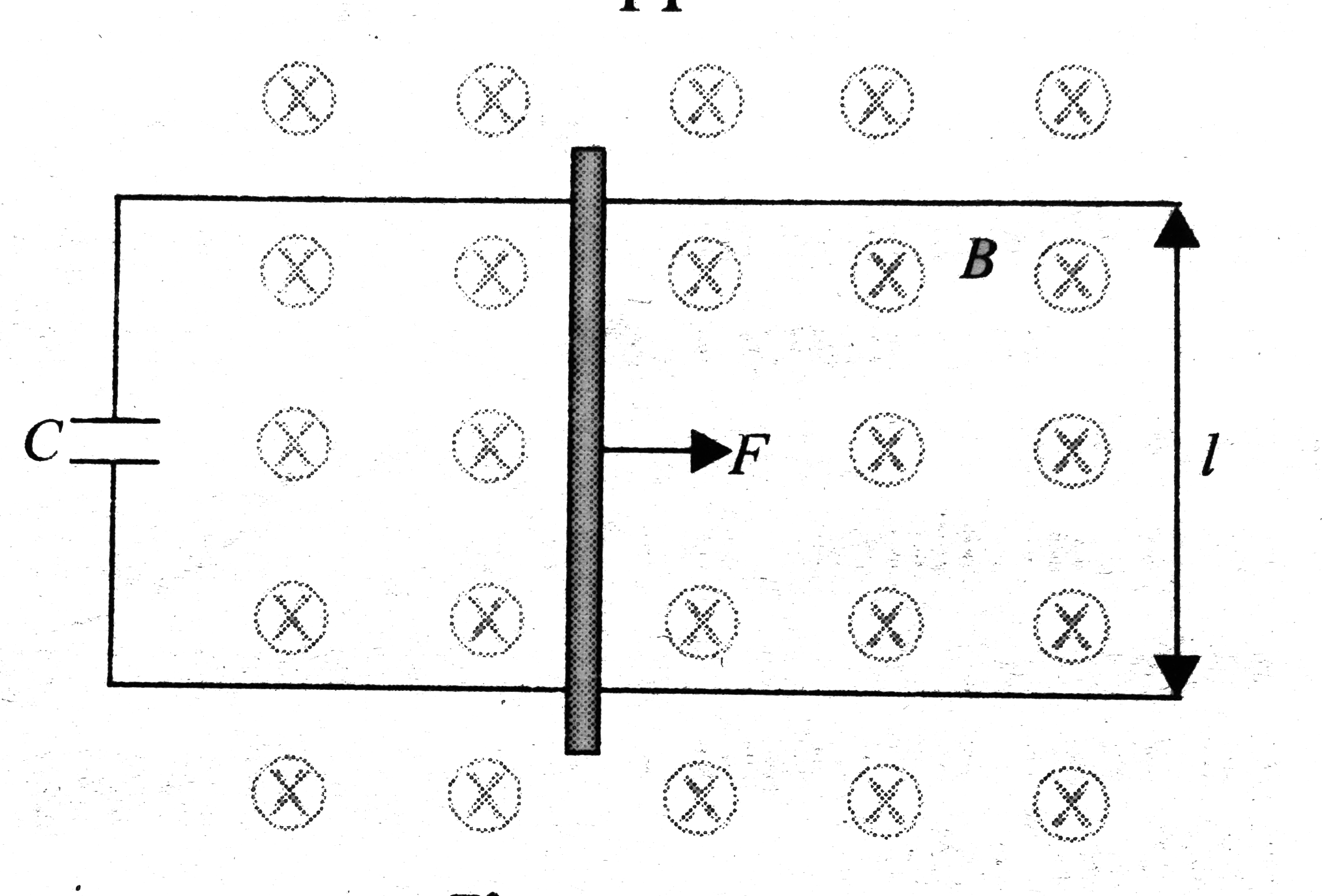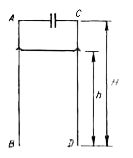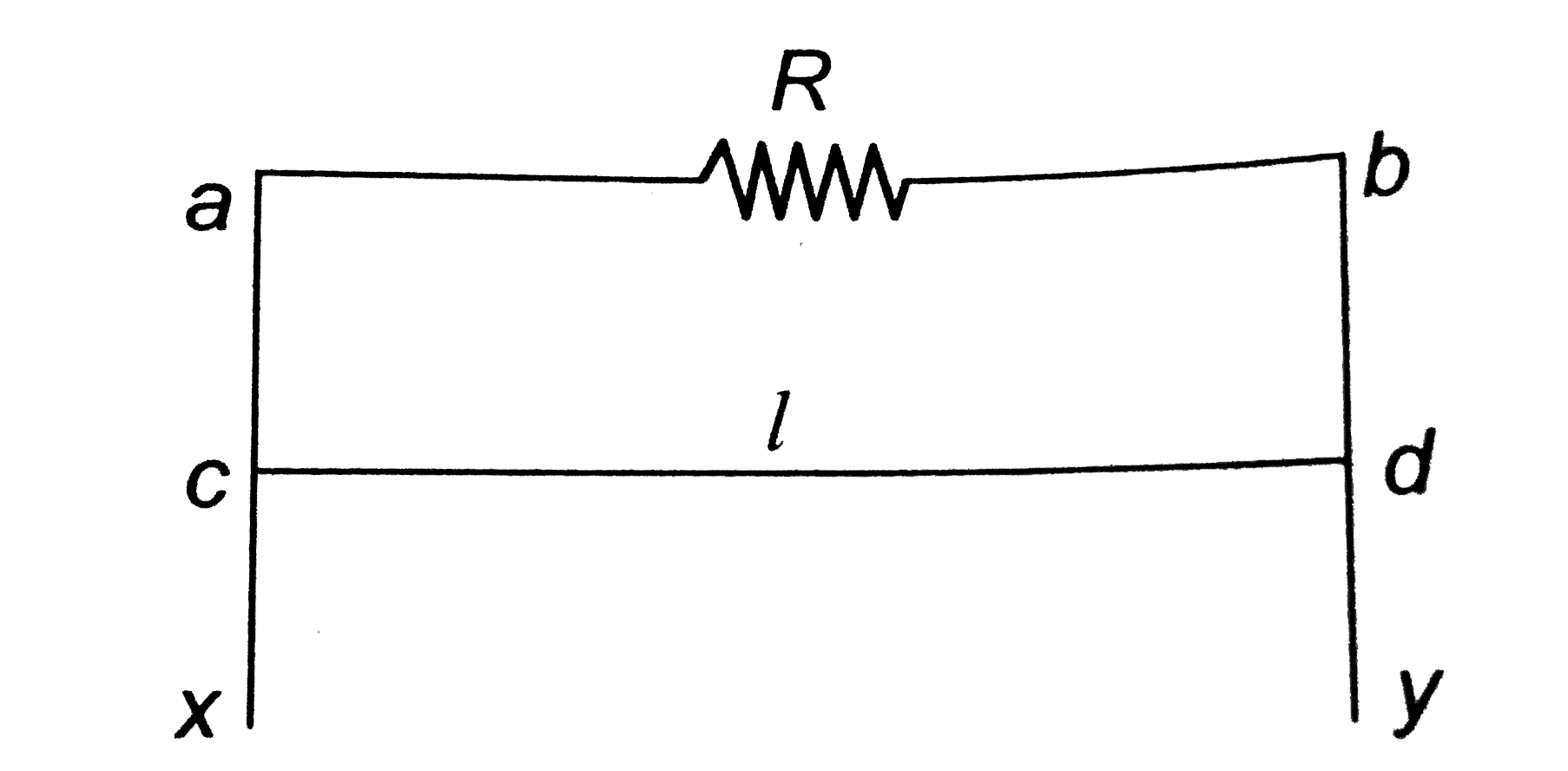A conductor of length l and mass m can slide without friction along the two vertical conductors connected at the top through a capacitor. A uniform magnetic field B is set up ⊥ to plane of paper. Find the voltage across the capacitor in terms of distance x through which it falls.

Bl.2gx
Bl√gx
Bl√2gx
Bx√2gl
E, the voltage across capacitor= induced emf across the slider =Blv
As capacitor does not permit flow of current, there is magnetic force on the rod to prevent its fall.
v2=2gx,v=√2gx
∴E=Bl.Sqrt(2gx)
Topper's Solved these Questions
- BOOK - MODERN PUBLICATIONCHAPTER - E.M. INDUCTION AND A.C. CURRENTS EXERCISE - MULTIPLE CHOICE QUESTIONS LEVEL -III (QUESTIONS FROM AIEEE/JEE EXAMINATION)14videos
E.M. INDUCTION AND A.C. CURRENTS
- BOOK - MODERN PUBLICATIONCHAPTER - E.M. INDUCTION AND A.C. CURRENTS EXERCISE - RECENT COMPETITIVE QUESTIONS31videos
E.M. INDUCTION AND A.C. CURRENTS
- BOOK - MODERN PUBLICATIONCHAPTER - E.M. INDUCTION AND A.C. CURRENTS EXERCISE - RECENT COMPETITIVE QUESTIONS31videos
E.M. INDUCTION AND A.C. CURRENTS
- BOOK - MODERN PUBLICATIONCHAPTER - DESCRIPTION OF MOTION IN TWO AND THREE DIMENSIONEXERCISE - Revision TEST36videos
DESCRIPTION OF MOTION IN TWO AND THREE DIMENSION
- BOOK - MODERN PUBLICATIONCHAPTER - ELECTROMAGNETIC WAVESEXERCISE - RECENT COMPETITIVE QUESTIONS4videos
ELECTROMAGNETIC WAVES
Similar Questions
A conductor of length l and mass m can slide without any friction along the two vertical conductors connected at the top through a capacitor. A uniform magnetic field B is set up ⊥ to the plane of paper. The acceleration of the conductor
 View Solution
View SolutionA conducting wire of length l and mass m can slide without friction on two parallel rails and is connected to capacitance C. Whole system lies in a magnetic field B and a constant force F is applied to the rod. Then
 View Solution
View Solution
Knowledge Check
- Question 1 - Select One
A conductor of length l and mass m can slide without any friction along the two vertical conductors connected at the top through a capacitor. A uniform magnetic field B is set up ⊥ to the plane of paper. The acceleration of the conductor
 Ais constantBIncreasesCdecreasesDcannot say
Ais constantBIncreasesCdecreasesDcannot say - Question 2 - Select One or More
A conducting wire of length l and mass m can slide without friction on two parallel rails and is connected to capacitance C. The whole system lies in a magnetic field B and a constant force F is applied to the rod. Then
Athe rod moves with constant velocityBthe rod moves with an acceleration of Fm+B2l2CCthere is constant charge on the capacitor.Dcharge on the capacitor increases with time - Question 3 - Select One
A conducting wire of length l and mass m can slide without friction on two parallel rails and is connected to capacitance C. Whole system lies in a magnetic field B and a constant force F is applied to the rod. Then
 Athe rod moves with constant velocityBthe rod moves with an acceleration of Fm+B2l2cCthere is constant charge on the capacitor.Dcharge on the capacitor increases with time
Athe rod moves with constant velocityBthe rod moves with an acceleration of Fm+B2l2cCthere is constant charge on the capacitor.Dcharge on the capacitor increases with time
A conducting wire of length l and mass m can slide without friction on two parallel rails and is connected to capacitance C. The whole system lies in amagnetic field B and a constant force F is applied to the rod . Then
 View Solution
View SolutionA conductor of length I and mass m can slide without friction, but with an ideal electrical contact, along two vertical conductors AB and CD connected through a capacitor (Fig. 30.2). Perpendicular to the plane of the figure a uniform magnetic held of induction B is set up. Find the voltage across the capacilor plates as a function of h.
 View Solution
View SolutionA conductor of length I and mass m can slide without friction, but with an ideal electrical contact, along two vertical conductors AB and CD connected through a capacitor (Fig. 30.2). Perpendicular to the plane of the figure a uniform magnetic held of induction B is set up. Find the voltage across the capacilor plates as a function of h.
 View Solution
View SolutionA conducting wire of length l and mass m can slide without friction on two parallel rails and is connected to capacitance C. The whole system lies in amagnetic field B and a constant force F is applied to the rod . Then
 View Solution
View SolutionA wire cd of length l and mass m is sliding without friction on conducting rails ax and by as shown. The verticle rails are connected to each other with a resistance R between a and b. A uniform magnetic field B is applied perpendicular to the plane abcd such that cd moves with a constant velocity of
 View Solution
View Solution

